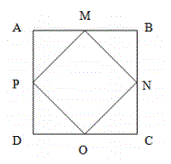| Problem |
Solution |
 1) ABCD and MNOP are squares. M, N, O, and P are at midpoints
of the four sides of the square ABCD. If MN is 8 inches, what is
the area of the square ABCD?
1) ABCD and MNOP are squares. M, N, O, and P are at midpoints
of the four sides of the square ABCD. If MN is 8 inches, what is
the area of the square ABCD? |
1.If the points MNOP are midpoints of the sides of ABCD, then the area of MNOP is 1/2 the area of ABCD.
2. The area of MNOP is 8 X 8 = 64 sq. in.
3. The area of ABCD = 2 X 64 = 128 sq. in.
|
|
2) Jenny build a pyramid out of sugar cubes to model a Mayan pyramid. Each layer is a solid
square of sugar cubes and the pyramid looks the same on all four sides. The bottom layer shows 10
cubes along each side. The next layer shows 9 cubes along each side and so on ending with one
cube on top. Jenny paints all the surfaces of the pyramid that are showing. How many cubes have
no paint on them?
|
1. If you lay out a square of cubes, 10 on a side (the bottom layer), then that makes 100 total cubes.
2. The cubes on just this one layer that will not have paint are the ones on the inside, making a square that is 8 cubes on a side.
3. Apply this to the remaining layers to compute the number of cubes that will not have any paint:
8 x 8 = 64
7 x 7 = 49
6 x 6 = 36
5 x 5 = 25
4 x 4 = 16
3 x 3 = 9
2 x 2 = 4
1 x 1 = 1
Total: 204 unpainted cubes
|
|
3) A cubic shaped fish tank is 40 inches tall. One quarter of the tank is filled with water. A metallic
cube is added to the tank that has edge length 30 inches. How much water in cubic inches is needed
to fill the tank the rest of the way? |
1. Compute the volume of the tank = 40 x 40 x 40 = 64,000 cu. in.
2. Compute the volume of the metallic cube = 27,000 cu. in.
3. Compute the tank volume - the cube volume - the 1/4 of the water in the tank = 64000 - 27000 - 64000/4 = 21,000 cu. in.
|